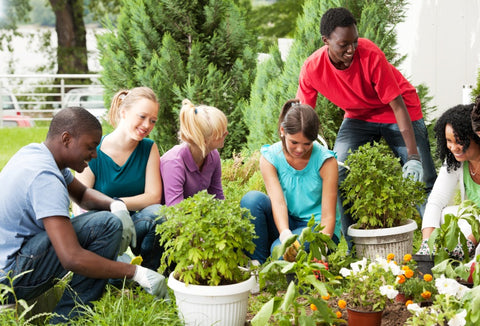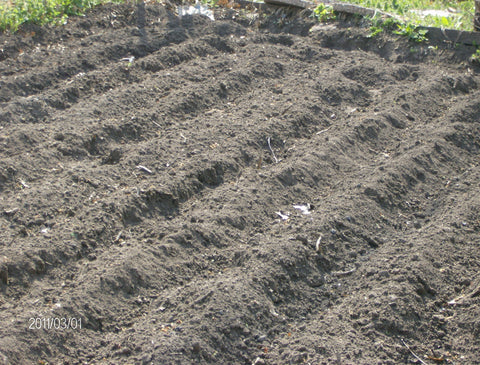Where to put a garden in your yard in Phoenix, Arizona
Choosing a location for your new garden is quick and easy once you understand the important factors. This article lays out those factors in order of importance and focuses on a few Phoenix-specific issues as well -- including that we are in the Northern hemisphere, there are lots of cinder block walls, and we have our own peculiar soil types. Read on to find out how these issues affect your gardening decisions.
Note: Stressed out by all this gardening research and DIY shopping trips to the home improvement stores? Schedule a free in-home consultation with Express Vegetable Gardens and we will help you plan a garden in the perfect location. We build full-service raised beds that include soil, frame, drip system, installation and a free beginner lesson. We serve the entire Phoenix Valley area.
#1 - Sunlight
The amount of sunlight that a spot in your yard will receive during the day will determine the strength and health of your plants along with what varieties you will be able to grow easily. Long story short, the ideal space will receive 6+ hours of unfiltered sun at all times of year. The sunlight can be continuous or it can be split into sections of the day with some shade in between.
To find out how much sun a space will get there are two major options: buy a garden sun light meter (~$10 on Amazon) or spend a day recording the amount of sunlight that a space is receiving every hour.
 Without measuring, there are some principles you can use to understand how the sun reaches each part of a yard. In the Northern hemisphere, the sun is always at least slightly to the South of you and rises in the East in the morning before setting in the West in the afternoon. This means that a tree or structure on the north side of your garden won't shade it drastically but you should avoid placing the garden anywhere that has tree or structure coverage coming from the south side. There are three major classifications for your garden depending on how much sun it gets during the day: full sun, partial sun and partial shade. These terms are important because you will find them on the instructions for different seed packets. A full sun garden receives more than 6 hours of sun and can grow the most different varieties of vegetables (likeliest to achieve by planting to the South and East of any shading objects). A partial sun garden receives 4-6 hours of sun and will still have a range of vegetable choices able to be planted. Finally, a partial shade garden receives 2-4 hours of sunlight and you will be very restricted in what you will be able to plant.
Without measuring, there are some principles you can use to understand how the sun reaches each part of a yard. In the Northern hemisphere, the sun is always at least slightly to the South of you and rises in the East in the morning before setting in the West in the afternoon. This means that a tree or structure on the north side of your garden won't shade it drastically but you should avoid placing the garden anywhere that has tree or structure coverage coming from the south side. There are three major classifications for your garden depending on how much sun it gets during the day: full sun, partial sun and partial shade. These terms are important because you will find them on the instructions for different seed packets. A full sun garden receives more than 6 hours of sun and can grow the most different varieties of vegetables (likeliest to achieve by planting to the South and East of any shading objects). A partial sun garden receives 4-6 hours of sun and will still have a range of vegetable choices able to be planted. Finally, a partial shade garden receives 2-4 hours of sunlight and you will be very restricted in what you will be able to plant.
#2 - Good Soil
A second major determinant of the success of your garden is the soil. In central Arizona there are two types of soil that you will usually find in your yard and neither of them are ideal for conventional vegetable gardening:
- Clay-heavy, alkaline soil with a very hard, layer of Caliche clay underneath that is difficult to dig or till and does not contain enough of the organic matter needed to grow dense quantities of vegetables. This hard Caliche layer also prevents plant roots from penetrating the ground sufficiently for full growth.
- Casa Grande soil is the main soil type in Central Arizona. This soil is very high in salt and low in nutrients that your plants need. This type of soil should be watered through several times before planting to reduce salinity.
Another consideration for gardeners who are working with the existing soil in their yard is the amount of grass seed in the existing area. Fully removing the existing grass or planting in an area with no grass is preferable because this will save you time later not having to constantly pluck grass from the garden bed.
In Arizona, therefore, it is very unlikely that you will have a desirable soil foundation in your yard for gardening without any additional soil enrichment. We recommend using raised beds for this reason as you will be using a custom store-bought soil that is designed for gardening and you therefore won't have to worry about salinity, lack of organic matter (nutrients), caliche blocking the roots, or grass seeds that make maintenance more difficult.
#3 - Where It Makes You Happy
 Enthusiasm is one of the key ingredients to successful gardening. Putting your garden in a spot that doesn't make you happy or feels like an ugly compromise can be a recipe for neglect and bad results. Instead, look for a place that is visible to you from your favorite window or patio chair so you can watch the plants grow and notice when maintenance or watering is needed. Put raised beds where you think they will compliment your other landscaping and where you will be encouraged to keep them looking healthy and clean. Remember that it's important to get the right amount of sun and the right kind of soil, but it's even more important to remember that the reason you are gardening is for your happiness. One good idea is to put it near an area where your kids play so they can treat helping in the garden as another part of their play activities!
Enthusiasm is one of the key ingredients to successful gardening. Putting your garden in a spot that doesn't make you happy or feels like an ugly compromise can be a recipe for neglect and bad results. Instead, look for a place that is visible to you from your favorite window or patio chair so you can watch the plants grow and notice when maintenance or watering is needed. Put raised beds where you think they will compliment your other landscaping and where you will be encouraged to keep them looking healthy and clean. Remember that it's important to get the right amount of sun and the right kind of soil, but it's even more important to remember that the reason you are gardening is for your happiness. One good idea is to put it near an area where your kids play so they can treat helping in the garden as another part of their play activities!
Other Considerations
- It can become very expensive and time-consuming to link a far-away plot to your existing water source for an automated watering system.
- Cinder block walls are in so many Phoenix yards. Make sure to place your garden at least 5 feet away from these walls to reduce shade while at the same time preventing the walls from radiating heat that will dry out the garden and require more frequent watering.
- Don't put your garden in the middle of a low area where water pools during rain or flooding as this will drown plants, disrupt the soil and rot wood more quickly.
If You Don't Have an Ideal Spot
If you don't have the ideal spot, there are several tactics you can use to work with your plot to make it more successful. The most important of these is to choose the right plant varieties, such as partial shade varieties to work in a spot with less sun. You should also make sure to plant taller plants on the side that will either block or not block sunlight on the rest of your garden, according to your needs. Finally, using a raised bed will almost always be an easier approach to making a certain spot work because you will have custom soil, better drainage and better protection from damage by pets and critters.
